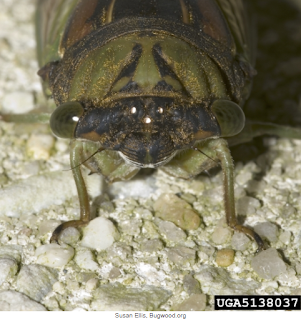Posted by John Murgel, Douglas County Extension
The “dog days” of summer bring with them some of the most
noticeable insect activity of the year—the sounds of insect calls. Step outside during the afternoon or evening
and you’re likely to hear a raucous mix of invertebrate “vocalizing”. Here are three of the most common.
1. Crickets. You’re probably familiar with the black, ground-dwelling Field Cricket. And yes, they chirp. But in areas with trees and shrubs (like most neighborhoods!) one of the most audibly noticeable crickets is the tree cricket. They are green and slender and smaller than field crickets, and spend most of their lives in trees and shrubs. Last year one of these managed to find its way into my house, and I can attest that they are loud. Shockingly so.
Primarily carnivorous (preying on other insects), the only
plant damage that they cause is during egg-laying, when females make small
wounds in twigs in which to oviposit.
These wounds can be unsightly as the plant grows over them, and may become
entry sites for fungi. The Showy Tree
Cricket is famous for chirping in correlation with temperature. Count the number of chirps you hear in 15
seconds and add 40—you should have the temperature in Fahrenheit! Good luck doing this when it's hot.
 |
| A tree cricket |
2. Cicadas. Colorado
is home to several species of cicada, though the famous “periodical cicadas”
are not among them (they occur mostly east of the Mississippi). The largest and loudest cicadas we have get
going in late summer. The “Plains
Harvest-fly” (Megatbicen dealbatus) and “Giant Grasslands Cicada” (M.
dorsatus) are most common. In order
to attract females, males “sing” by using tymbal organs on their abdomen,
producing sounds that are amplified by resonating throughout the insect’s body
(much like the resonator on a musical instrument). Adult cicadas usually live a month or two,
but their juvenile phase, which takes place underground, can last several years.
 |
| Dog-day cicada, head on! |
3. Katydids. In
Colorado, the most common katydid is the Broadwinged Katydid, Microcentrum
rhombifolium. They mature in late
summer, and are quite large—up to two inches from head to wing-tips. They are well camouflaged, being green with
very leaf-like venation on their wings.
Unlike their eastern relative, the “true” Katydid, Broadwinged Katydids
do not make a “katy-did” call, rather they click and hiss softly by using
specialized structures on their wings.
You might find katydid egg masses on twigs in your trees or shrubs; they
are flat, tan, and laid in a double-row often resembling shingles or
scales. They are laid in late summer and
fall and won’t hatch until the following spring—keep an eye out for them while
you’re doing your wintertime pruning!
 |
| An adult broadwinged katydid. |
If you can’t get enough bugs, or just wonder what insects
and other arthropods you might see out
and about in our state, check out the Arthropods
of Colorado site, developed by CSU Extension’s entomology program.




























